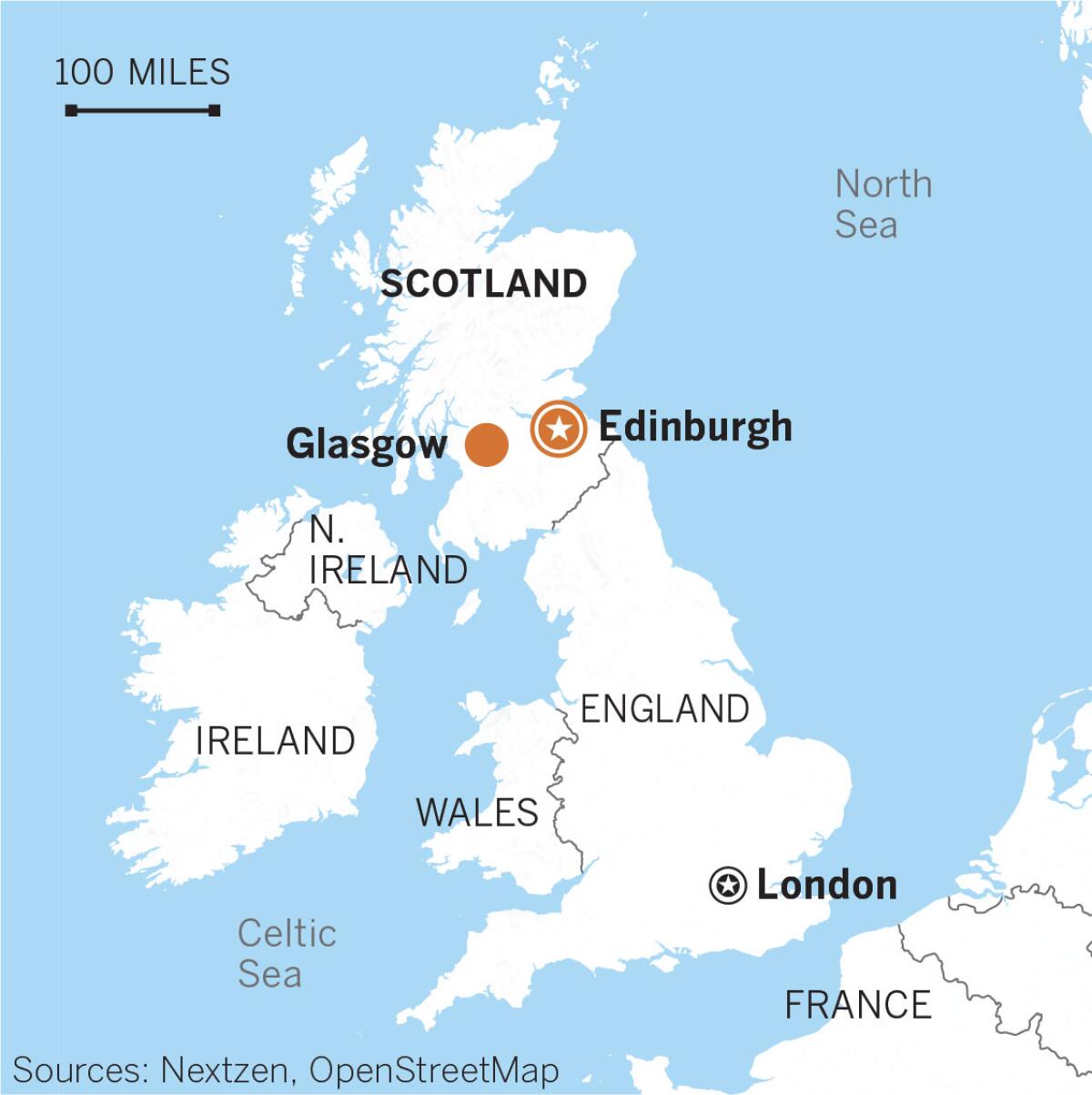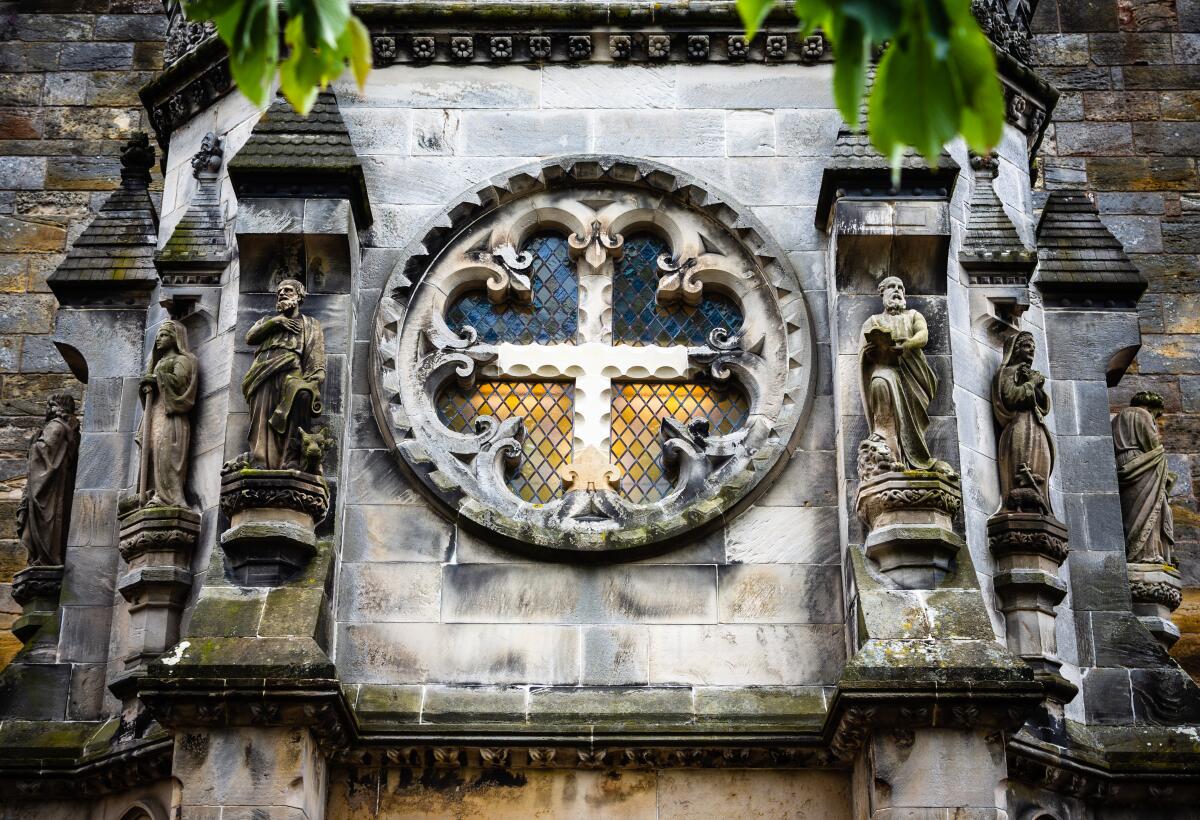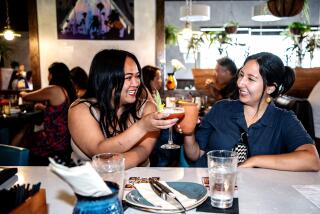Scotland a foodie haven? ’Tis true. And so is this: Haggis is kind of great
- Share via
EDINBURGH, Scotland — I had planned an extensive food itinerary for a week in Scotland, with stops at noteworthy restaurants that are helping to expunge the country’s reputation as a land of porridge and offal. But those plans didn’t take into account that our arrival in Edinburgh would disrupt the most important ritual of my day: lunch.
Desperate, my husband, Steve, and I wandered around the city center and
spotted Badger & Co., a restaurant that looks like a cross between a drinking club and a child-centric library.
My 8-year-old self would have scowled at the menu, but she wasn’t in charge. We shared a savory tart (shallots, thyme, goat cheese and lentil salsa), two shots of 14-year-old Oban Scotch and an order of haggis balls, a mix of offal, spices and grains that was then breaded and fried.
I don’t think I’ve met anyone who likes haggis (or is willing to try it), but the spheres were hot, with a crisp, salty crust. A few delicious bites that fueled our continued exploration until it was time for our next meal.
Badger & Co. isn’t one of the restaurants where local chefs are transforming the country’s food landscape, prompting ecstatic reports from travelers and critics on the front lines of what has in in the last decade become known as “the new Scottish cuisine.”

But our random encounters with pub and street food during our week-long trip in October reminded us that a successful journey is a mix of high-low experiences: planning for the cutting edge and being open to sampling the new — or, at least, the new to us.
Plans are great, but they come with expectations. Surprises — happy surprises — can make us hopeful and, perhaps, bolder as we explore new worlds.
Base camp
Our home base in Edinburgh was the Bonham Hotel in the West End neighborhood, a relatively easy walk to many of the city’s biggest attractions, including Edinburgh Castle, which we were scheduled to visit on our second day in Scotland.
Before we entered the castle complex, we stopped at the nearby Amber Restaurant, where we loaded up on strong coffee and millionaire bars — layers of shortbread, caramel and chocolate that may or may not have originated in Scotland. The sugar and caffeine propelled us through a three-hour visit.
The castle, built on a hill with amazing views of the city, is actually a series of buildings constructed over several centuries. Military enthusiasts could spend days wandering around the grounds inspecting the Great Hall; the Mons Meg, a 15th century cannon; and the National War Museum. We checked those off our list and then detoured to the Royal Palace and the Honours of Scotland, the oldest crown jewels in Britain.
Afterward, we meandered down Castlehill, a street lined with tourist shops and pubs, and stumbled upon the Ensign Ewart. Ensign Charles Ewart earned war hero status at the Battle of Waterloo in 1815. But I will remember him because this pub is where I tasted my first Scotch egg, an almost hard-boiled egg wrapped in a layer of sausage, then breaded, fried and served warm with a dollop of chutney.
Most nights, our random encounters took a back seat to our reservations, which is how we ended up at the Scran & Scallie in the Stockbridge neighborhood of Edinburgh, known for its upscale shops, bars and restaurants.
Months later, we continue to reminisce about the meal, which started with ox tongue with bone marrow, mushrooms and a fried hen’s egg in a red wine reduction. Fish and chips were lighter than air. The flaky crust of a steak pie was a lovely counterpoint to the rich beef broth and savory meat, carrots and mushrooms.
Abbeys and more
We next headed south with an itinerary that included Rosslyn Chapel, Melrose Abbey, Dryburgh Abbey — and lunch.
Rosslyn Chapel, a 20-minute drive, is a 15th century place of worship whose popularity skyrocketed after publication of Dan Brown’s “The Da Vinci Code” and the movie that followed.
The densely plotted novel emphasized connections among the chapel, the Knights Templar and the Holy Grail — connections that continue to be debated among academics and religious scholars. But it was difficult to contemplate controversy as we explored the building and its pillars and carvings. We were too dazzled to think about anything but its beauty.
After our tour of the chapel, we drove to the small town of Melrose and a reservation at Provender, where we were forced to abandon our notions about small-town dining. We started with Jerusalem artichoke velouté, a luxurious cream-based soup made with smoked haddock. An order of crowdie, a fresh curd cheese, was served with beetroot, sorrel and horseradish sorbet — a wonderful contrast with the cool dairy flavors. The bavette steak with bone marrow was a tribute to salt and fat.

Our next stop, Melrose Abbey, is a draw for anyone interested in Scottish history and the destruction wreaked over centuries by invaders from the south. Construction began in the 12th century, and you can see still gargoyles and saints carved into the Gothic structure. Even though much of the abbey is in ruins, it is impossible to overstate its beauty.
The same can be said of Dryburgh Abbey, where a guide dressed as a stone mason took a few minutes to explain the intricacies of stone cutting. Nearby, sheep grazed in emerald pastures, oblivious to the follies of history.
A few hours later back in Edinburgh,
we eagerly set out for Brasserie Prince by Alain Roux in the Balmoral Hotel on the edge of the Old Town neighborhood.
The sleek, sophisticated restaurant is a tribute to Parisian bistros. Herb-crusted rack of lamb arrived perfectly pink atop a bed of vegetables, and the rabbit was served with rich grain mustard sauce that enhanced the meat’s delicate flavor. We topped it off with a vanilla mille-feuille before lapsing into a food coma.
The next morning, we took a train to Glasgow and checked into the Kimpton Blythswood Square Hotel, near the City Centre and a mile or two from Glasgow Cathedral and many of the other things we hoped to see.
You could spend hours in the enormous 13th century church, musing about the men (and very few women) whose lives are memorialized with stone slabs and brass plaques and gazing at the remarkable stained glass windows. You also could spend hours wondering why it wasn’t destroyed by various waves of angry English armies. (Most histories note that the cathedral quickly “adapted” to Protestant worship in the 16th century.)
Time for lunch
It was a lot of history and art for one morning, so we went in search of a late lunch, eventually sinking into the plush booths at the Citizen in City Centre, where I learned to appreciate the charms of cullen skink, a thick soup with smoked haddock, potatoes and onions, reminiscent of clam chowder and served with thick slices of sourdough bread.
We spent three nights in Glasgow and had three memorable dinners, the first at Ox and Finch, a restaurant in the Finnieston neighborhood that for the last couple of years has been heralded in various travel write-ups as the “hippest place in the U.K.”
The food was all about small or shared plates, and we ordered plenty. The venison carpaccio with juniper and peppercorn, hazelnuts and crowdie, dressed with vinegar and cold smoked oil — was a favorite, thanks to a mix of salty, acidic and sweet flavors.
We were skeptical about the buffalo mozzarella — recalling the packaged stuff we purchase on occasion — served with Isle of Wight tomatoes, but the cheese was fresh and tangy and the tomatoes were ripe. Duck confit was served with grilled eggplant, yogurt and dukkah, an Egyptian spice blend that helped to balance the rich duck fat.
The next night, we walked to Ubiquitous Chip, where our meal started with creamy duck liver pâté dusted with ground pistachios — a seductive pairing of salty and sweet, crunchy and silky. Wild mushrooms were served with a quail egg, charred shallot and onion juice, an earthy, creamy mashup. The heat of the pepper in the steak au poivre was an ideal counterpoint to the rich flavor of the meat.
On our last night in Glasgow, we ate at the Two Fat Ladies, a cozy restaurant known for its seafood. Our scallops were firm and buttery, the sole, flaky with a subtle lemon finish. At the end of the meal, we nibbled on sticky toffee pudding with crème anglaise and toasted the end of our Glaswegian experience with a 14-year-old Scotch.
If you go
THE BEST WAY TO EDINBURGH, SCOTLAND
From LAX, Delta, United, American and British offer connecting service (change of planes) to Edinburgh. Restricted round-trip airfare from $934, including taxes and fees.
WHERE TO STAY
Bonham Hotel, 35 Drumsheugh Gradens, Edinburgh. Doubles from about $300 a night.
Kimpton Blythswood Square Hotel, 11 Blythswood Square, Glasgow. Doubles start at about $200.
WHERE TO EAT
Badger & Co., 32 Castle St., Edinburgh. Savory fare, $15-$40.
Amber Restaurant at the Scotch Whisky Experience, 354 Castlehill, Edinburgh.
Expansive Scotch menu as well as seasonal menus. Most dishes, $15-$30.
Ensign Ewart, 521 Lawnmarket, Edinburgh. Scotch eggs, haggis, sandwiches and other pub fare, $7-$30.
Scran & Scallie, 1 Comely Bank Road, Edinburgh. The meat-heavy menu features ox tongue, steak pie and Wagyu beef burgers. $15-$35.
Provender, West End House, High Street, Melrose, Scotland. Modern cooking in a small-town setting. $14-$40.
Brasserie Prince by Alain Roux , 1 Princes St., Edinburgh. Sophisticated cuisine at the Balmoral hotel.
The Citizen, 24 St. Vincent Place, Glasgow. A mix of traditional and international dishes $14-$25.
Ox and Finch, 920 Sauchiehall St., Glasgow. Small-plate menu in a hip neighborhood, $10-$20.
Ubiquitous Chip, 12 Ashton Lane, Glasgow. A Glasgow favorite with a modern take on Scottish dishes. $13-$45.
Two Fat Ladies City Centre, 118A Blythswood St., Glasgow. Cozy restaurant known for its seafood. Most dishes $7-$30.
More to Read
Sign up for The Wild
We’ll help you find the best places to hike, bike and run, as well as the perfect silent spots for meditation and yoga.
You may occasionally receive promotional content from the Los Angeles Times.







